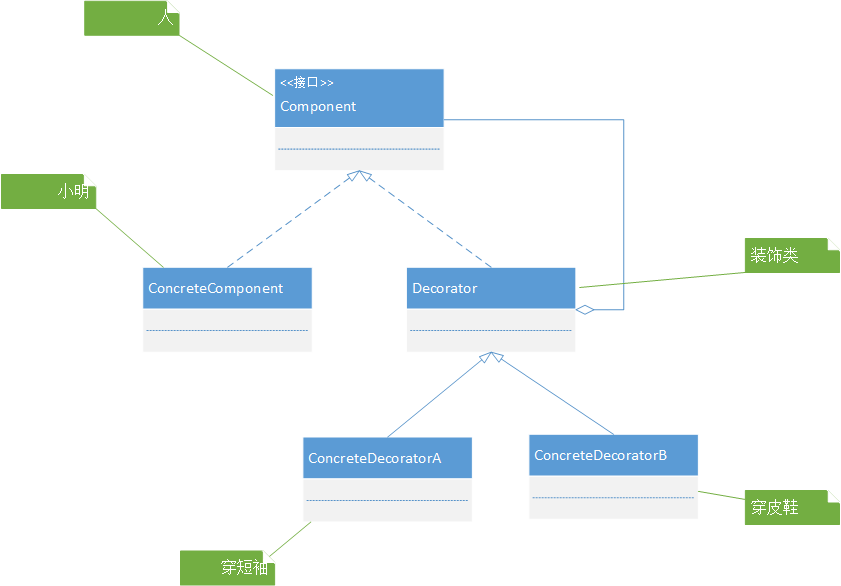这里只简单说说装饰模式,因为对这个模式理解得还不是很透彻。暂时不能写出更深一点的内容。
什么是装饰模式呢?拟定一个场景,一个人需要穿衣打扮,我们可以写一个Person类,为它定义出N个方法,穿短袖,穿皮鞋,等等。要新增一个装饰的时候,我们在Person类里新增一个方法即可,但这违背了“方法-封闭”原则。如何写出更好更加灵活的代码呢?我们用装饰模式来实现这个场景。小明先穿短袖,后穿皮鞋。
穿短袖、穿皮鞋等等,我们把这些装饰方法干脆抽象出来成一个装饰类,不同的装饰继承实现这个类。人定义为一个接口,小明是一个具体的人继承“人”接口。同时装饰类聚合并且实现“人”接口,这点也是我暂时没法深入理解的问题所在。有点绕口,我们还是先画出UML类图。

清楚类结构后,我们照着类结构来实现代码。
首先定义Component抽象构件(装饰类装饰的是抽象构件)接口。
1 package day_6_decorator; 2 3 /** 4 * 抽象构件 5 * @author turbo 6 * 7 * 2016年9月9日 8 */ 9 public interface Component { //人 10 void operation(); 11 }
实现这个Component抽象构件,创建一个ConcreteComponent具体构件。
1 package day_6_decorator; 2 3 /** 4 * 具体构件 5 * @author turbo 6 * 7 * 2016年9月9日 8 */ 9 public class ConcreteComponent implements Component { //小明 10 11 /* (non-Javadoc) 12 * @see day_6_decorator.Component#Operation() 13 */ 14 @Override 15 public void operation() { 16 System.out.println("具体对象的操作"); 17 } 18 19 }
定义装饰类。
1 package day_6_decorator; 2 3 /** 4 * 装饰类 5 * @author turbo 6 * 7 * 2016年9月9日 8 */ 9 public class Decorator implements Component { 10 private Component component; 11 12 public void setComponent(Component component) { 13 this.component = component; 14 } 15 /* (non-Javadoc) 16 * @see day_6_decorator.Component#Operation() 17 */ 18 @Override 19 public void operation() { 20 if (component != null){ 21 component.operation(); 22 } 23 } 24 25 }
定义具体装饰类ConcreteDecorateA。
1 package day_6_decorator; 2 3 /** 4 * 具体装饰类A 5 * @author turbo 6 * 7 * 2016年9月10日 8 */ 9 public class ConcreteDecoratorA extends Decorator { 10 private String addedState; //本类独有功能 11 12 @Override 13 public void operation() { 14 super.operation(); 15 addedState = "new State"; 16 System.out.println("穿短袖"); 17 } 18 19 }
定义具体装饰类ConcreteDecorateB。
1 package day_6_decorator; 2 3 /** 4 * 具体装饰类B 5 * @author turbo 6 * 7 * 2016年9月10日 8 */ 9 public class ConcreteDecoratorB extends Decorator { 10 11 @Override 12 public void operation() { 13 super.operation(); 14 addedBehavior(); 15 } 16 17 /** 18 * 19 */ 20 private void addedBehavior() { 21 System.out.println("穿皮鞋"); 22 } 23 24 }
客户端代码。
1 package day_6_decorator; 2 3 /** 4 * @author turbo 5 * 6 * 2016年9月10日 7 */ 8 public class Main { 9 10 /** 11 * @param args 12 */ 13 public static void main(String[] args) { 14 ConcreteComponent c = new ConcreteComponent(); 15 ConcreteDecoratorA d1 = new ConcreteDecoratorA(); 16 ConcreteDecoratorB d2 = new ConcreteDecoratorB(); 17 18 d1.setComponent(c); 19 d2.setComponent(d1); 20 d2.operation(); 21 } 22 23 }
输出结果。

这样我们就用两个装饰类对小明做了装饰,并且可以随意调换装饰的顺序。暂时还不能深入地聊下装饰模式,待我理解比较透彻再来深入理解下,不过这个装饰模式好像和Java的动态代理机制倒是有几分相似。同样在之后也会仔细研究研究。